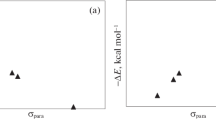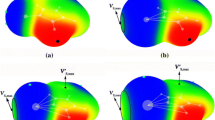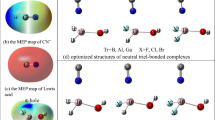Abstract
The ternary complexes X- · 1 · YF (1 = triazine, X = Cl, Br and I, Y = H, Cl, Br, I, PH2 and AsH2) have been investigated by MP2 calculations to understand the noncovalently electron-withdrawing effects on anion-arene interactions. The results indicate that in binary complexes (1 · X-), both weak σ-type and anion-π complexes can be formed for Cl- and Br-, but only anion-π complex can be formed for I-. Moreover, the hydrogen-bonding complex is the global minimum for all three halides in binary complexes. However, in ternary complexes, anion-π complex become unstable and only σ complex can retain in many cases for Cl- and Br-. Anion-π complex keeps stable only when YF = HF. In contrast with binary complexes, σ complex become the global minimum for Cl- and Br- in ternary complexes. These changes in binding mode and strength are consistent with the results of covalently electron-withdrawing effects. However, in contrast with the covalently electron-withdrawing substituents, Cl- and Br- can attack the aromatic carbon atom to form a strong σ complex when the noncovalently electron-withdrawing effect is induced by halogen bonding. The binding behavior for I- is different from that for Cl- and Br- in two aspects. First, the anion-π complex for I- can also keep stable when the noncovalent interaction is halogen bonding. Second, the anion-π complex for I- is the global minimum when it can retain as a stable structure.




Similar content being viewed by others
References
Quiñonero D, Garau C, Rotger C, Frontera A, Ballester P, Costa A, Deyà PM (2002) Anion-π interactions: do they exist? Angew Chem, Int Ed 41:3389–3392
Schottel BL, Chifotides HT, Dunbar KR (2008) Anion-π interactions. Chem Soc Rev 37:68–83
Mascal M, Armstrong A, Bartberger MD (2002) Anion-aromatic bonding: a case for anion recognition by π-acidic rings. J Am Chem Soc 124:6274–6276
Alkorta I, Rozas I, Elguero J (2002) Interaction of anions with perfluoro aromatic compounds. J Am Chem Soc 124:8593–8598
Dawson RE, Hennig A, Weimann DP, Emery D, Ravikumar V, Montenegro J, Takeuchi T, Gabutti S, Mayor M, Mareda J, Schalley CA, Matile S (2010) Experimental evidence for the functional relevance of anion-π interactions. Nat Chem 2:533–538
Ballester P (2013) Experimental quantification of anion-π interactions in solution using neutral host-guest model systems. Acc Chem Res 46:874–884
Berryman OB, Bryantsev VS, Stay DP, Johnson DW, Hay BP (2007) Structural criteria for the design of anion receptors: the interaction of halides with electron-deficient arenes. J Am Chem Soc 129:48–58
Hay BP, Bryantsev VS (2008) Anion-Arene adducts: C-H hydrogen bonding, anion-π interaction, and carbon bonding motifs. Chem Commun 2417–2428
Hay BP, Custelcean R (2009) Anion-π interactions in crystal structures: commonplace or extraordinary? Cryst Growth Des 9:2539–2545
Frontera A (2013) Encapsulation of anions: macrocyclic receptors based on metal coordination and anion–π interactions. Coord Chem Rev 257:1716–1727
Frontera A, Quiñonero D, Deyà PM (2011) Cation–π and anion–π interactions. WIREs Comput Mol Sci 1:440–459
Frontera A, Gamez P, Mascal M, Mooibroek TJ, Reedijk J (2011) Putting anion-π interactions into perspective. Angew Chem, Int Ed 50:9564–9583
Estarellas C, Bauza A, Frontera A, Quiñonero D, Deyà PM (2011) On the directionality of anion-π interactions. Phys Chem Chem Phys 13:5696–5702
Garau C, Frontera A, Quiñonero D, Ballester P, Costa A, Deyà PM (2004) Cation-π versus anion-π interactions: energetic, charge transfer, and aromatic aspects. J Phys Chem A 108:9423–9427
Garau C, Frontera A, Quiñonero D, Ballester P, Costa A, Deyà PM (2005) Approximate additivity of anion-π interactions: an Ab initio study on anion-π, anion-π2 and anion-π3 complexes. J Phys Chem A 109:9341–9345
Chen Y-S (2013) Theoretical study of interactions between halogen-substituted s-triazine and halide anions. J Phys Chem A 117:8081–8090
Schneider H, Vogelhuber KM, Schinle F, Weber JM (2007) Aromatic molecules in anion recognition: electrostatics versus hydrogen -bonding. J Am Chem Soc 129:13022–13026
Garau C, Frontera A, Quiñonero D, Ballester P, Costa A, Deya PM (2003) A topological analysis of the electron density in anion-π interactions. Chem Phys Chem 4:1344–1348
Zheng X-Y, Shuai Z-G, Wang D (2013) Anion-binding properties of π-electron deficient cavities in Bis(tetraoxacalix[2]arene[2]triazine): a theoretical study. J Phys Chem A 117:3844–3851
Kim D, Lee EC, Kim KS, Tarakeshwar P (2007) Cation-π-anion interaction: a theoretical investigation of the role of induction energies. J Phys Chem A 111:7980–7986
Kim DY, Singh NJ, Kim KS (2008) Cyameluric acid as anion-π type receptor for ClO4 - and NO3 -: π-stacked and edge-to-face structures. J Chem Theory Comput 4:1401–1407
Kim DY, Singh NJ, Lee JW, Kim KS (2008) Solvent-driven structural changes in anion-π complexes. J Chem Theory Comput 4:1162–1169
Demeshko S, Dechert S, Meyer F (2004) Anion-π interactions in a carousel copper(II)-triazine complex. J Am Chem Soc 126:4508–4509
Rosokha YS, Lindeman SV, Rosokha SV, Kochi JK (2004) Halide recognition through diagnostic“anion-π” interactions: molecular complexes of Cl-, Br-, and I- with olefinic and aromatic π receptors. Angew Chem, Int Ed 43:4650–4652
de Hoog P, Gamez P, Mutikainen I, Turpeinen U, Reedijk J (2004) An aromatic anion receptor: anion-π interactions do exist. Angew Chem, Int Ed 43:5815–5817
Schottel BL, Bacsa J, Dunbar KR (2005) Anion dependence of Ag(I) reactions with 3,6-Bis(2-Pyridyl)-1,2,4,5-Tetrazine (bptz): isolation of the molecular propeller compound [Ag2(bptz)3][AsF6]2. Chem Commun 46–47
Mascal M, Yakovlev I, Nikitin EB, Fettinger JC (2007) Fluoride-selective host based on anion-π interactions, ion pairing, and hydrogen bonding: synthesis and fluoride-ion sandwich complex. Angew Chem, Int Ed 46:8782–8784
Wang D-X, Zheng Q-Y, Wang Q-Q, Wang M-X (2008) Halide recognition by tetraoxacalix[2]arene[2]triazine receptors: concurrent noncovalent halide-π and lone-pair-π interactions in host−halide−water ternary complexes. Angew Chem, Int Ed 47:7485–7488
Kebarle P, Chowdhury S (1987) Electron affinities and electron-transfer reactions. Chem Rev 87:513–534
Alberto ME, Mazzone G, Russo N, Sicilia E (2010) The mutual influence of Non-covalent interactions in π-electron deficient cavities: the case of anion recognition by tetraoxacalix[2]-arene[2]triazine. Chem Commun 46:5894–5896
Zuo C-S, Quan J-M, Wu Y-D (2007) Oxa-bicyclocalixarenes: a New cage for anions Via C−H · · · anion hydrogen bonds and anion · · · π interactions. Org Lett 9:4219–4222
Wang D-X, Wang Q-Q, Han Y, Wang Y, Huang Z-T, Wang M-X (2010) Versatile anion-π interactions between halides and a conformationally rigid Bis(tetraoxacalix[2]arene[2]triazine) cage and their directing effect on molecular assembly. Chem–Eur J 16:13053–13057
Lucas X, Estarellas C, Escudero D, Frontera A, Quinonero D, Deya PM (2009) Very long-range effects: cooperativity between anion-π and hydrogen-bonding interactions. Chem Phys Chem 10:2256–2264
Escudero D, Frontera A, Quinonero D, Deya PM (2009) Interplay between anion-π and hydrogen bonding interactions. J Comput Chem 30:75–82
Quinonero D, Frontera A, Garau C, Ballester P, Costa A, Deya PM (2006) Interplay between cation–π, anion–π and π–π interactions. Chem Phys Chem 7:2487–2491
Frontera A, Quinonero D, Costa A, Ballester P, Deya PM (2007) MP2 Study of cooperative effects between cation–π, anion–π and π–π interactions. New J Chem 31:556–560
Estarellas C, Frontera A, Quinonero D, Deya PM (2011) Theoretical study on cooperativity effects between anion–π and halogen-bonding interactions. Chem Phys Chem 12:2742–2750
Das A, Choudhury SR, Estarellas C, Dey B, Frontera A, Hemming J, Helliwell M, Gamez P, Mukhopadhyay S (2011) Supramolecular assemblies involving anion–π and lone pair–π interactions: experimental observation and theoretical analysis. Cryst Eng Comm 13:4519–4527
Seth SK, Sarkar D, Kar T (2011) Use of π–π forces to steer the assembly of chromone derivatives into hydrogen bonded supramolecular layers: crystal structures and hirshfeld surface analyses. Cryst Eng Comm 13:4528–4535
Seth SK, Saha I, Estarellas C, Frontera A, Kar T, Mukhopadhyay S (2011) Supramolecular self-assembly of M-IDA complexes involving lone-pair · · · π interactions: crystal structures, hirshfeld surface analysis, and DFT calculations [H2IDA = iminodiacetic acid, M = Cu(II), Ni(II)]. Cryst Growth Des 11:3250–3265
Choudhury SR, Gamez P, Robertazzi A, Chen CY, Lee HM, Mukhopadhyay S (2008) Experimental observation of supramolecular Carbonyl-π/π-π/π-carbonyl and Carbonyl-π/π-π/π-anion assemblies supported by theoretical studies. Cryst Growth Des 8:3773–3784
Seth SK, Sarkar D, Jana AD, Kar T, Mukhopadhyay S (2011) On the possibility of tuning molecular edges to direct supramolecular self-assembly in coumarin derivatives through cooperative weak forces: crystallographic and hirshfeld surface analyses. Cryst Growth Des 11:4837–4849
Choudhury SR, Dey B, Das S, Gamez P, Robertazzi A, Chan KT, Lee HM, Mukhopadhyay S (2009) Supramolecular lone pair−π/π−π/π−anion assembly in a Mg(II)−malonate−2-aminopyridine−nitrate ternary system. J Phys Chem A 113:1623–1627
Das A, Choudhury SR, Dey B, Yalamanchili SK, Helliwell M, Gamez P, Mukhopadhyay S, Estarellas C, Frontera A (2010) Supramolecular assembly of Mg(II) complexes directed by associative lone Pair−π/π−π/π−Anion−π/π−Lone pair interactions. J Phys Chem B 114:4998–5009
Li Q-Z, Lin Q-Q, Li W-Z, Cheng J-B, Gong B-A, Sun J-Z (2008) Cooperativity between the halogen bond and the hydrogen bond in H3N · · · XY · · · HF complexes (X, Y=F, Cl, Br). Chem Phys Chem 9:2265–2269
Li Q-Z, Li R, Liu Z-B, Li W-Z, Cheng J-B (2011) Interplay between halogen bond and lithium bond in MCN-LiCN-XCCH (M = H, Li, and Na; X = Cl, Br, and I) complex: the enhancement of halogen bond by a lithium bond. J Comput Chem 32:3296–3303
Li Q-Z, Li R, Liu X-F, Li W-Z, Cheng J-B (2012) Concerted interaction between pnicogen and halogen bonds in XCl-FH2P-NH3 (X=F, OH, CN, NC, and FCC). Chem Phys Chem 13:1205–1212
Alkorta I, Blanco F, Elguero J, Estarellas C, Frontera A, Quinonero D, Deya PM (2009) Simultaneous interaction of tetrafluoroethene with anions and hydrogen-bond donors: a cooperativity study. J Chem Theory Comput 5:1186–1194
Alkorta I, Sanchez-Sanz G, Elguero J, Del Bene JE (2012) Influence of hydrogen bonds on the P · · · P pnicogen bond. J Chem Theory Comp 8:2320–2327
Janet E, Del Bene JE, Alkorta I, Goar S-S, Elguero J (2013) Phosphorus as a simultaneous electron-pair acceptor in intermolecular P · · · N pnicogen bonds and electron-pair donor to Lewis acids. J Phys Chem A 117:3133–3141
Lu Y-X, Liu Y-T, Li H-Y, Zhu X, Liu H-L, Zhu W-L (2012) Energetic effects between halogen bonds and anion-π or lone pair-π interactions: a theoretical study. J Phys Chem A 116:2591–2597
Frisch MJ, et al. (2003) Gaussian 03; Gaussian, Inc.: Wallingford, CT
Boys SF, Bernardi F (1970) Calculation of small molecular interactions by differences of separate total energies – some procedures with reduced errors. Mol Phys 19:553–566
Reed AE, Curtiss LA, Weinhold F (1988) Intermolecular interactions from a natural bond orbital. Donor-acceptor viewpoint. Chem Rev 88:899–926
Bader RWF (1990) Atoms in molecules. A quantum theory. Clarendon, Oxford
Biegler-König F (2000) AIM2000. University of Applied Sciences, Bielefeld
Acknowledgments
Supported by the High Performance Computing Center, Kunming Institute of Botany, CAS, China.
Author information
Authors and Affiliations
Corresponding author
Electronic supplementary material
Below is the link to the electronic supplementary material.
ESM 1
(DOC 157 kb)
Rights and permissions
About this article
Cite this article
Chen, Y., Yao, L. Theoretical study of X- · 1 · YF (1 = triazine, X = Cl, Br and I, Y = H, Cl, Br, I, PH2 and AsH2): noncovalently electron-withdrawing effects on anion-arene interactions. J Mol Model 20, 2076 (2014). https://doi.org/10.1007/s00894-014-2076-0
Received:
Accepted:
Published:
DOI: https://doi.org/10.1007/s00894-014-2076-0




